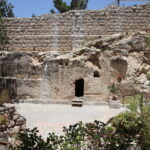On a recent trip through Nova Scotia, my family and I drove through the beautiful historic town of Mahone Bay, where three lovely old churches sit by the water’s edge. Sadly, all three of them have been gutted by theological liberalism, and have lost that gospel beauty which shines forth from local churches where spiritual life is abundant. All that remains is the beauty of the traditional architecture upon the canvas of a picturesque background. This kind of architectural and aesthetic beauty I’ll call “cathedral beauty” for the purposes of this article.

Here are two truths: cathedrals are beautiful; the gospel is beautiful. But often these two forms of beauty are often estranged from one another, for the churches which are the most beautiful in architecture are, from my perspective as an evangelical, often the ones without the gospel beauty of true spiritual life. And, in an irony that has been nagging at me increasingly over the years, the kinds of churches that would seem to have an abundance of vital spiritual life are often plain, utilitarian, and even ugly. Why might this be the case?
But before addressing those questions directly, it’s important to lay a bit of groundwork—a foundation, you might say—arguing for the goodness of architecture.
God’s Geometry
I am increasingly convinced that there is something divine about architecture, that geometry and form and ratios can capture something of the organizing genius of the Grand Architect, the Master Builder of the universe. It is said that above the entry to Plato’s school of philosophy were engraved the words: “Let no one ignorant of geometry enter.” Why geometry? Why not long division? Why not grammar or geography? But in fact there is something almost magical about geometry. And if not quite magical, then certainly mystical, for every school of esoteric mysticism seems quite enamoured with it. If this makes no sense to you, as it made no sense to me not very long ago, I blame our impoverished modern utilitarian education.
Consider: why should it be the case that with only a compass and a straight edge, one can draw a perfect circle, an equilateral triangle, a square, and even the perfect representation of a cube? No measurements are required. With these same two instruments, one can also draw a series of rectangles that embody in their length and width the mysterious golden ratio (which is 1.618, if you’re wondering), a specific mathematical relationship which comes up again and again in Creation: from petals, pine cones, seed heads, and seashells to hurricanes, spiral galaxies, the proportions of the human face, and even DNA molecules.
These simple grade-school shapes are deceivingly profound. To try and explain why these numbers, ratios, and shapes are found in nature and are inherently pleasing to the human eye is to wade into deep waters that have occupied and fascinated great minds since at least ancient Greece, and perhaps much longer. For our purposes, I merely want to make the point that when we talk about geometry, and the related field of architecture, we are touching upon something which is both a mystery and a gift, known fully only by the One who “upholds the universe by the word of his power” (Hebrews 1:3). Or as Thomas Aquinas wrote, “God, who is the first principle of all things, may be compared to things created as the architect is to things designed.”[1]
Indeed, that is what the author of the best-selling architecture book of all time concluded. “I was led from architecture to the intellectual knowledge of God,” wrote Christopher Alexander. “It was my love of architecture and building from which I slowly formed an edifice of thought that shows us the existence of God as a necessary, real phenomenon as surely as we have previously known the world as made of space and matter.”[2]
This resonates with what the Apostle Paul wrote in Romans 1:19-20, “For what can be known about God is plain to them, because God has shown it to them. For his invisible attributes, namely, his eternal power and divine nature, have been clearly perceived, ever since the creation of the world, in the things that have been made.” The architect Alexander describes an experience that illustrates the above verses about as well as I’ve ever heard: “In my heart, I was always dimly aware that I did maintain an inner knowing that the best way to produce good architecture must somehow be linked to God—indeed, that valuable architecture was always about God, and that this was the source of any strength I had in being able to identify the real thing.”[3]
He was not alone in this “inner knowing.” According to art historian Otto von Simson, the medieval schools which gave rise to the Gothic cathedrals were steeped in this kind of thinking. In a fascinating journal article from 1952, he argued that we moderns can scarcely grasp the role that geometry played in the minds of the medieval builders whose stunning works millions of people are drawn to visit every year. By examining the preserved minutes from a meeting held in 1391 in Milan, von Simson showed that the architects, despite their arguments and various differences of opinion, were united on the supremacy of geometry. “It is taken for granted by both sides that the stability and the beauty of the edifice are not distinct, do not obey different laws, but are both comprehended in the perfection of geometrical forms.”[4]
He goes on to state that the “masters of Chartres, like the Platonists and Pythagoreans of all ages, were obsessed with mathematics; it was considered the link between God and world.” Indeed, “the school of Chartres attempted to transform theology into geometry. The attempt, which appears so strange to us, conveys a glimpse of what geometry meant to the twelfth century.”[5]
But this flowering of geometry and architecture in the twelfth century had deeper roots still. One of the thinkers and theologians they revered was Augustine, who thought deeply about how music and architecture relate to the nature and structure of reality. Von Simson explains: “Because true beauty is, according to Augustine, anchored in a metaphysical reality, the contemplation of visual and musical harmony will actually lead the soul to the experience of the ultimate harmony and unity that is God.”[6]
It was Augustine’s view of architecture, along with that of Boethius, that taught the medieval Gothic builders this way of thinking. This is why the architects of the Gothic period had themselves depicted with “ruler and compass in hand, as geometricians. With these same attributes the creator himself was represented.”[7]
After only this cursory dip into the history and literature of this period, it starts to dawn on us that something far deeper than a shift in aesthetics took place to give us the Gothic cathedral. It was the culmination of a whole different way of seeing and understanding the created world and our place in it, as well as the role of beauty.

Considering Beauty
But isn’t beauty in the eye of the beholder? Many of us moderns have been taught to think so. There are certainly varieties in opinion about beauty, and various cultural expressions of it, but aesthetic beauty itself is not endlessly subjective, and it was only the noxious fumes of post-modernism that made such an idea plausible. The Christian tradition has long held to the unity of the three transcendentals—truth, goodness, and beauty—as objective realities which emanate from and find their source in God.
When humans are not oriented towards those things, as when ideology colonizes the mind, then we get a sharp divergence in artistic taste and style, not because beauty is subjective, but because the natural taste for beauty has been subverted and replaced with something that serves the ideology. Postmodern and Soviet architecture illustrate this point beautifully by being so perfectly hideous.
It is common to hear the objection that Protestants, and evangelicals especially, have the ugliest churches. This brings us back to our opening question about why gospel churches are often plain, utilitarian, and even ugly. There is some truth to this, and as always a little history goes a long way to explaining why. Let’s consider two reasons. First, evangelicalism is largely a revival movement that took place (or was pushed) outside the main established Protestant denominations, and so, it found itself having to meet outside of the oldest, largest, and most beautiful churches.
The latest local example of this repeated pattern might be what happened with the Canadian evangelical Anglican churches who took a stand against their liberalizing denomination. They were willing to lose their beautiful historic buildings in order to preserve the beautiful historic gospel.
The second reason is less easily excused: evangelicals have just not valued beauty very much. Rather, they have typically chosen to focus heavily on evangelistic outreach and church multiplication to the detriment and exclusion of aesthetic considerations. If we think about those three transcendentals again—truth, goodness, and beauty—I’d say evangelicals have tended to prioritize them in that order: truth above all, goodness coming in second, and beauty last.
Evangelicals might argue that it is wrongheaded to focus on the aesthetics of the building because what really matters is what happens inside the building and inside the hearts of the people gathered there. And if I had to choose between aesthetic beauty or gospel beauty, there is no question which I would choose. Church plants often find themselves meeting in rented school gyms by necessity.
But many churches don’t have to choose between the two. And what if beauty itself has more evangelistic power than we tend to assume? We’re going to be building and renovating and decorating churches either way, so why not think deeply about what our buildings communicate? This is where we not only have room to grow, but need a shift in our thinking.
Recovering the Power of Beauty
It was Winston Churchill who remarked, “We shape our buildings; thereafter they shape us.” I was reminded of this as I read Rod Dreher’s most recent book, Living in Wonder, which included an extended reflection on architecture and beauty. “If our buildings and our built environments look and feel machinelike and inhuman,” writes Dreher, “we are fooling ourselves if we think religion can inject meaning into architecture from the outside.”[8]
He goes on to make this provocative statement: “This is why converting everyone in the city to Christianity, but leaving questions of beauty in art and architecture unaddressed, will have only a limited effect on reversing the pervasive feeling of alienation.”[9] It may be worth noting that Dreher’s journey from adolescent atheism towards Christian faith was jump-started by an experience of transcendence as he stood inside the epic Chartres cathedral in France. For Dreher, the evangelistic power of beauty and architecture is personal.
This “pervasive feeling of alienation” is how Dreher describes the contemporary experience of so many in the modern West. Dreher argues that modernity gave us a view of creation as just “dead matter” that could be re-worked and re-shaped according to our whims. This was a radical departure from the medieval model, which saw the universe as a unified whole and an intricately designed masterpiece which reflected God as well as the whole spiritual realm. It should come as no surprise that these two fundamentally different ways of interpreting the created world gave rise to very different ways of designing buildings.
The medieval mind wanted to build something that would resonate in harmony with the deep patterns of creation, but the modern architect is taught to eschew conventions, to find some new way to be transgressive, and to find ways of manifesting in the physical building the metaphysical conviction that there is no organizing principle that gives the world its particular shape. Unfortunately for them, they must still follow both the laws of physics and local building codes.
Can we say then that beauty has an important role to play in awakening modern, disenchanted men and women? Dreher certainly thinks so. He makes his case by drawing on the work of Timothy G. Patitsas and his book, The Ethics of Beauty. Patitsas writes, “Eros is the beginning of human moral life, and beauty in art and literature are oftentimes more effective than religion in awakening eros within us. Religion can just seem like God coming down at us, scolding us, telling us to stay where we are, but just do better. But real religion must awaken the movement in the other direction, must make us come out of ourselves and move toward him, falling in love with him. It’s about beginning an adventure, becoming a pilgrim, an exile, a lover.”[10]
Patitsas argues, in a way that one rarely hears in evangelical circles, that there is something uniquely attractive both morally and spiritually about beauty which awakens desire (“eros”) for God. Absent this element of desire awakened by beauty, the propositional truths about the gospel message fail to set a fire of love for God in the soul.
This is closely related to John Piper’s central insight. We desire God when we perceive God’s beauty (or glory) because that is how the human soul responds to beauty. But I have almost never heard an evangelical make the connection between this and the importance of aesthetic beauty in our buildings, our worship, our homes, and our communities.
Reconciling Cathedral Beauty and Gospel Beauty
Consider the staggering fact that millions of modern people travel from all over the world every year to visit the great cathedrals of Europe. Why? What draws them? What compels them? It is more than historical curiosity–it is the power of beauty. This raises an important question: have evangelicals underappreciated the spiritual and evangelistic value of beauty? I think we have, though that doesn’t mean we have to agree with all the arguments of Dreher and Patitsas, both of whom are Eastern Orthodox.
One of the things I love about our tradition is that it is always reforming, always willing to consider the spiritual and Biblical merits of a new argument or an old corrective. And as Dr. Michael Haykin loves to point out in his lectures, Baptists (and other Protestant groups) have historically placed a high value on architecture and aesthetic beauty, something which seems to have slipped during the 20th century.
What would it look like if evangelicals took this challenge seriously? Well, we might prioritize holding on to historic and beautiful buildings, as well as purchasing those that come up for sale. We might develop a network of like-minded Christian architects and builders who specialize in designing and constructing new churches that are objectively, classically beautiful and which elevate the soul.
We might even prioritize the study of architecture in Christian schools and at home, not to mention other forms of art. We might draw inspiration from the wide array of beautiful Protestant (and other) churches of every size that exist all over the world, each reflecting their own era and culture, and yet each sharing that unmistakable element of beautiful design that is pleasing to the eye. It may be the case today that cathedral beauty tends to be estranged from gospel beauty, but there is no reason why that should remain the case.
So why do we need beautiful churches? The simplest answer is: because God is beautiful, the universe he made is beautiful, and the gospel of lavish grace is beautiful. To willingly have ugly churches, then, is a kind of inconsistency, if not an untruth.
With God’s help, let’s make our buildings as beautiful as we can make them, and may the congregations within them be marked by the gospel beauty of the Spirit’s work, all to the glory of the Grand Architect.

[1] Thomas Aquinas, Summa Theologica: I, Q. 27, Art. 1.
[2] Christopher Alexander, “Making the Garden,” First Things, February, 2016, https://www.firstthings.com/article/2016/02/making-the-garden
[3] Alexander, “Making the Garden.”
[4] Otto G. von Simson, “The Gothic Cathedral: Design and Meaning,” Journal of the Society of Architectural Historians 11, no. 3 (October 1952): page 10, https://www.jstor.org/stable/987608
[5] von Simson, “The Gothic Cathedral,” 11.
[6] von Simson, “The Gothic Cathedral,” 11.
[7] von Simson, “The Gothic Cathedral,” 13.
[8] Rod Dreher, Living in Wonder (Grand Rapids: Zondervan, 2024), 185.
[9] Dreher, Living in Wonder, 185.
[10] Timothy G. Patitsas, The Ethics of Beauty (Maysville, MO: St. Nicholas Press, 2019), 54. Quoted in Living in Wonder.
























